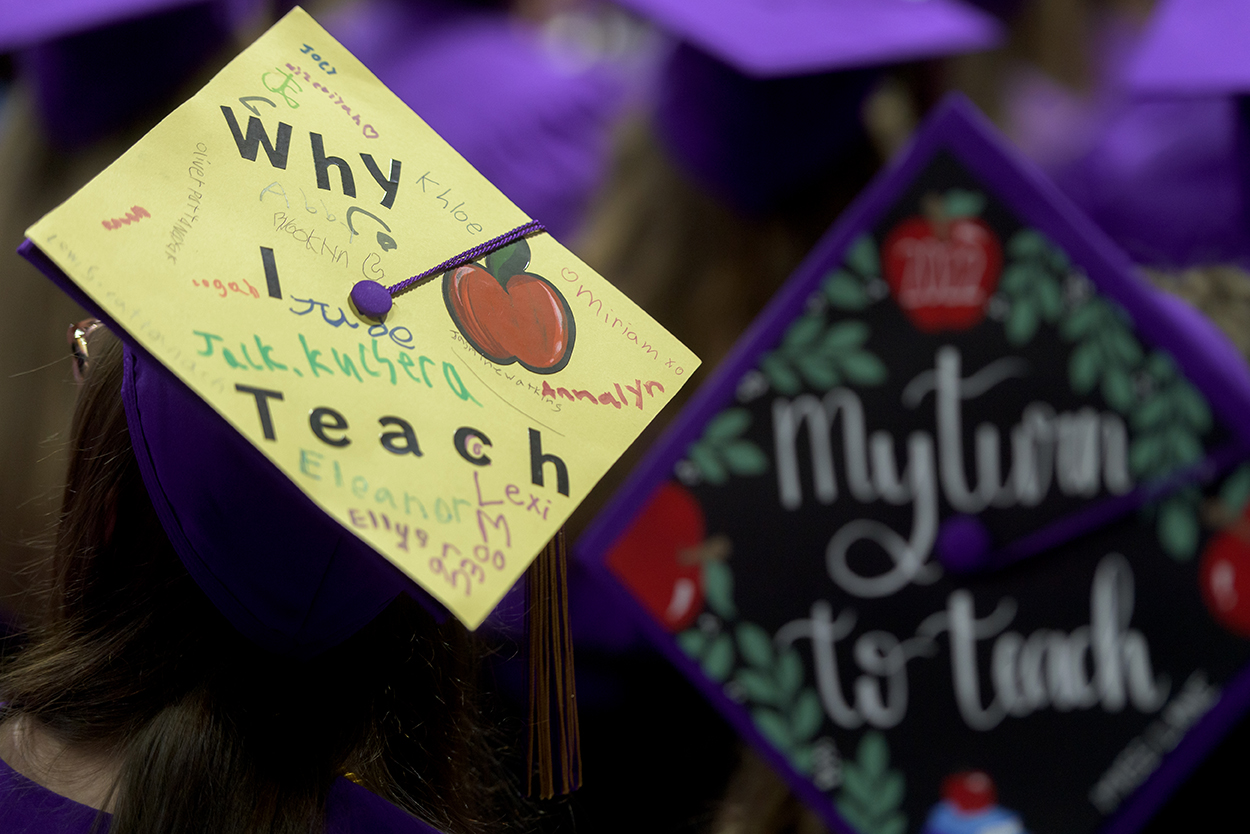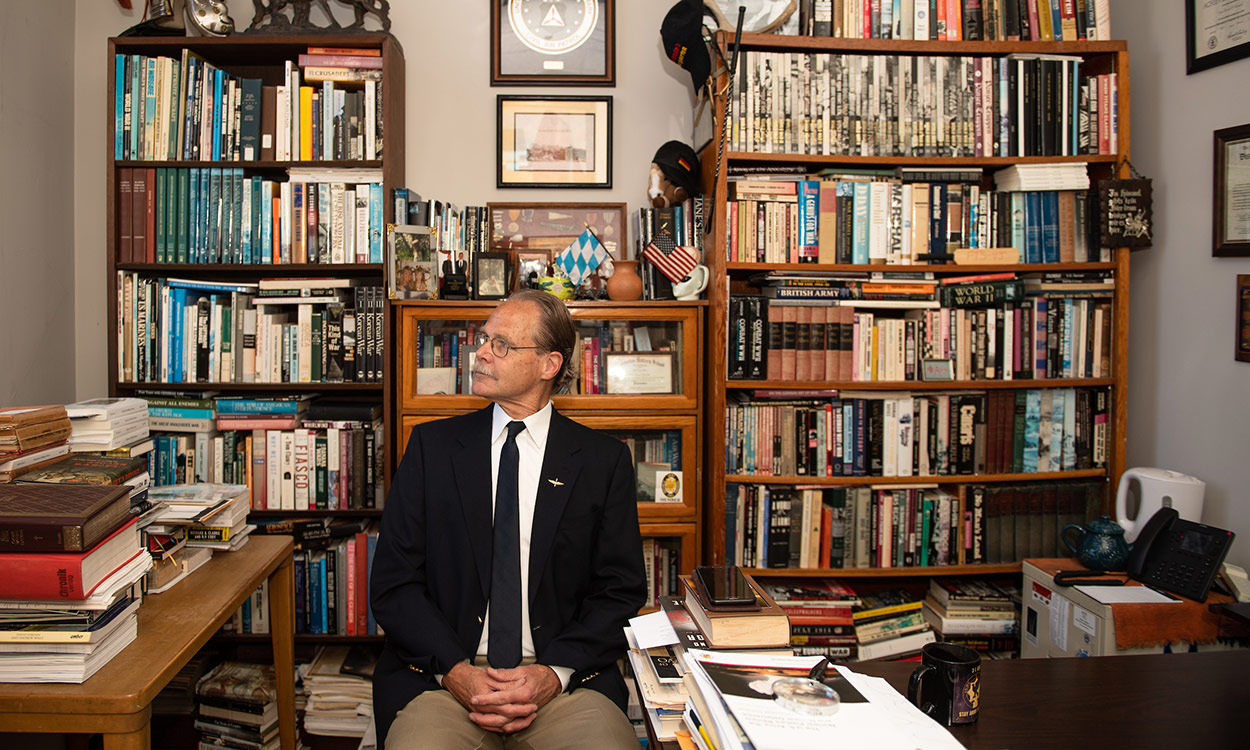






Teaching Teachers

By Geoff Cantrell
Continuing to produce top teachers in the region
There wasn’t a single thing or a precise moment that led to Keiara Newsome ’22 deciding she wanted to become a schoolteacher. For the Charlotte resident, the career choice was an evolution, coming from some key personal realizations made during her early years as a student at Western Carolina University. “I knew that I had a passion for helping others, working with children and mathematics,” said Newsome. “My mother has been in the education system for as long as I can remember, so I recalled stories she had told me about her students and experiences. … And I want to be an inspiration, beacon and a supporter of learning – just like my mom. Western helps students find their way, develop academically and personally, and is so supportive that I decided to change direction during my sophomore year.”
Once she had declared her major, she knew she was in the right place. “The staff and faculty invested their time, talents and efforts into me, as a person, both in and out of the classroom,” Newsome said. “From the time I entered the program to graduation day, I was doing classroom observations, interacting with students and learning about myself as an educator.”

Newsome did her student teaching stint at Iotla Valley Elementary School in Franklin and now is teaching math in 7th and 8th grades at a private Christian school in Wisconsin. Finding a job, and her ideal job at that, wasn’t hard for Newsome. School systems everywhere are seeking qualified candidates at a time when they are experiencing an increased need to maintain adequate staff. Some of the recent attrition comes from post pandemic societal change, a large faction of the workforce taking retirement and career departures due to job stress. According to the North Carolina Department of Public Instruction, the teacher shortage is well publicized, confirming school districts are having difficulty in hiring. This inability to educate students with qualified instructors results in a future workforce that cannot meet the needs of a modern economy.
North Carolina must fulfill the needs of more than 100 school districts and 3,000-plus
schools. During a May meeting, the University of North Carolina System Board of Governors
stepped in and approved a refreshed strategic plan that included, among other goals,
a new priority to increase the number of system-educated first year public school
employees from 4,643 to 4,800 by 2026-27.
WCU has high expectations for helping to meet that goal. “Much of the teacher and
leadership workforce in our region has been trained by our programs and many professionals
have multiple degrees from our institution,” said Kim Winter, dean of the College
of Education and Allied Professions. “We now serve students who come from all over
the state and well beyond, but we continue that tradition and commitment to our region.”

Winter has outlined the College of Education and Allied Professions pathways to strengthening and diversifying the teacher pipeline: “Our mission is to improve student-learning outcomes by changing the way we prepare teachers and our vision is to prepare teachers who can demonstrate improved student learning. We want to ensure that every child is taught by a well-prepared teacher – one who graduates ready for the classroom on day one. Here at Western, we are dedicated to creating a campus reflective of our core values and offer educational programs that prepare our students for the diverse world in which they already live.”
Effective teachers have school leadership who dedicate time and resources to ensure they receive the support, acknowledgement and professional growth they deserve. WCU recognizes preparation programs must develop rigorous curriculum and clinical experiences that contribute to a continuum of teacher learning and growth that begins with instruction and continues into the profession, in partnership with the schools in which they teach, Winter said.
The landscape of the K-12 teaching environment across the U.S. lends itself to being predominantly white and mostly female. Male teachers are not nearly as common and male teachers of color tend to be rare. When the majority of students in public schools are students of color and only 18 to 20% of teachers are people of color, there is an urgent need to act. There is strong evidence that students of color benefit from having teachers and leaders who look like them as role models. They also benefit from the classroom dynamics that diversity creates. “And we must remember that it is equally important for our white students to see teachers of color in leadership roles – in their classrooms and in their communities. The need is urgent and so the question really becomes, how do we address this quickly and thoughtfully?” Winter asked.

One recent action has been a partnership with Clemson University to become part of a program titled “Call Me MISTER,” which is an acronym for Mentors Instructing Students Toward Effective Role Models. The goal is to increase the pool of available male teachers of color in the Western North Carolina region and across the state. “I’m very proud of the Call Me MISTER program because to me it fulfills our college and university’s inclusive excellence mission,” said Charmion Rush, director of Call Me MISTER at WCU and associate professor in the College of Education and Allied Professions’ Inclusive Education program.
“It’s proof in the pudding. They’re putting their money where their words are; they’re putting their action into place,” she said. “I think this program is wonderful because it eliminates some of those systemic barriers that we know keep people of color, especially men of color, from being as successful as they would like to be.” A first step is commitment to the preparation of a representative and inclusive pipeline into the teaching profession. This commitment includes adopting pathway programs that target students in middle and high school to get them to consider teaching as an option. It also means embracing equity practices and policies that assist in the elimination of systemic barriers currently in place which often prevent people from entering the profession.
“We recognize that increases in our racial equity performance data will not occur overnight but having the courage to commit to a collective agenda that challenges us too, is essential,” said Winter. At a time when public universities are experiencing enrollment declines in teacher education, WCU is not. There’s a myriad of reasons why. One factor that alumni, past and present faculty and many school administrators quickly point to is the sense of history and place found in Cullowhee when it comes to teacher education.
When the institution that would become WCU was started in 1889, founder Robert Lee Madison wanted to provide an education for young people and train teachers for service in the rural mountain communities. Around the time America entered World War I, the institution had revised the curriculum and offered three junior college degree programs: teaching, classics and vocational agriculture. Almost all the students attending at the time chose teaching.
The latter aspect morphed to the point when, on the eve of the Great Depression in 1929, the institution became designated Western Carolina Teachers College. It would remain as such until 1967, when the institution was named a regional university by the North Carolina General Assembly and given its current title of Western Carolina University. “I think Western has such an amazing tradition of teacher education,” said Angela Lunsford ’92, principal of the Catamount School, WCU’s laboratory school in partnership with Jackson County Schools for 6th through 8th grades located in Sylva. “That foundation and the rich storied history is second to none in any comparison,” she said.

Lunsford is in a unique position as principal of the Catamount School, which opened in August 2017 on the campus of Smoky Mountain High School. Here, teachers ensure each area of the curriculum emphasizes a problem-centered approach that develops critical reasoning and promotes a deeper understanding of subject material. “A word we use a whole lot is ‘purposeful.’ We try to be purposeful in everything we do, and our teachers are so good at being purposeful for the whole student, the community and themselves,” Lunsford said. “I look at how well the university and the school work together. Our students have such positive role models, with interns and volunteers from other programs coming in, assisting classrooms and on one-on-one bases.” The Catamount School is designed to serve students who may not reach their full academic potential in a traditional classroom, so innovative strategies are used to keep students fully engaged and learning. Only 25 students are accepted for each grade level annually. It also provides student teachers, interns and volunteers a broader experience in preparation in the teaching profession.
“What drew me to Western and its teaching program specifically was the amount of exposure I knew I would get to the classroom before I was actually teaching,” said Holly Miller, who began as a volunteer before becoming an intern at the Catamount School. “At Western, they make an effort that first semester you’re in the College of Ed to get you into a classroom and see teaching and learning taking place. You get to make connections with kids, you see the administrative side, you get a complete range of experiencing the teaching profession. “I think one of the great benefits of the Catamount School is its proximity to Western,” she said. “Laboratory schools sometimes can be some distance away from the home institution, but here we are just an extension, literally down the road.”
The teaching profession sets high standards and requirements and that holds true for teaching programs as well. Patricia Bricker, professor and associate dean for academic affairs, said WCU teacher education programs have longstanding accreditation with the National Council for Accreditation of Teacher Education. In 2014, that council and the Teacher Education Accreditation Council merged with the Council for the Accreditation of Educator Preparation. This year, the teacher education program gained accreditation from Council for the Accreditation of Educator Preparation, effective through spring 2029. In its report, the council found no areas for improvement or stipulations for WCU.

“Professional accreditation from this highly-regarded, national organization demonstrates
that we provide high quality teacher and professional education programs at both initial
and advanced levels,” Bricker said. “Our candidates develop a deep understanding of
learners, content, instructional practice and professional responsibility and are
supported from recruitment through program completion and their beginning years in
the field. We are committed to effective partnerships with PreK-12 schools and helping
to meet the educational needs of our region.”
The College of Education and Allied Professions was ranked among the nation’s top teacher preparation programs in early reading instruction by the National Council on Teacher Quality. The nonprofit research and policy organization awarded an “A grade” to WCU’s degree program in elementary education, for preparing graduates to teach reading to elementary school students. The same organization also named WCU among the best in the nation when it comes to ensuring future elementary teachers have the essential skills needed to teach math. “We know how much math matters in setting a foundation for students,” said Heather Peske, National Council on Teacher Quality president. “The biggest in-school difference we can make for students’ math learning is to make sure their elementary teachers understand key math content and know how to teach math effectively. Western Carolina University should be proud to be among the top teacher preparation programs in the country working toward this goal.”
The aforementioned Robert Lee Madison, the first teacher at the Cullowhee Academy and whose “Cullowhee Idea” subsequently inspired other normal schools across the state, passed away in 1954. By that time teacher education, while still a favorite curriculum on WCU’s campus, was sharing the limelight with the many other programs being offered. The institution had become so much more than a teacher’s college and was evolving even further. And while the university is so much more today than ever before, “we are proud of the fact that Western began as a teaching college in 1889,” said Winter. “We’re looking forward to the next hundred or so years.”


